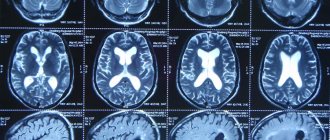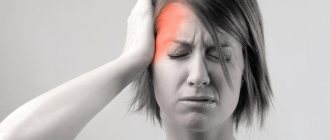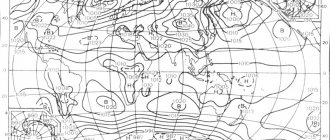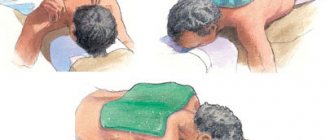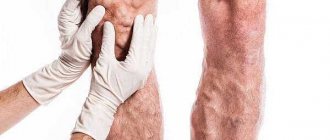Hypertension occurs in different ways; some people feel it if their blood pressure has risen by 10-20 mm Hg. st and complains of nausea, pressure in the temples and headaches. But for some, 200/120 is not a problem; without a tonometer, they won’t even suspect this problem. In any case, a rise in pressure above 140/90 mmHg. Art. causes harm to the body, and above 170/110 mmHg. Art. is fraught with danger. Shoot down? Of course, every cardiologist will answer. Fast and up to standard? But here everything is not so clear.
High pressure target
Whatever the reason for the rise in pressure, the result is the same - the wall of the blood vessels is overloaded, and the formed elements of the blood and large molecules, for example, glucose, like plates with sharp edges, scratch the vascular wall from the inside more and more. And the more microcracks there are, the faster cholesterol will be deposited in them, and the faster an atherosclerotic plaque will begin to form in this place. Well, some organs, which are usually called target organs of hypertension, suffer directly from high blood pressure - the heart is pumped up like a bodybuilder’s biceps, but this only affects its nerves and arteries, the kidneys become overgrown with connective tissue (nephrosclerosis develops), the optic nerve swells and vision deteriorates, the brain suffers. But... even for such serious complications, the count is not in hours or days. This is the result of prolonged, months of high blood pressure.
First aid for high blood pressure
If you have a headache, the first thing you need to do is measure your blood pressure with a tonometer. Its increase to 140/90 or more indicates the likelihood of hypertension and crisis. If this occurs for the first time, you should definitely consult a doctor or call an ambulance. You should not take any medications without examination and prescription from a doctor. To alleviate the condition, you need to lie in a bed with a high pillow, put a cold towel on your head and wait for the doctor. If you have already been prescribed medications for blood pressure, you need to take those that are intended for emergency use. As a rule, it is kapoten or corinfar.
Consequences of a sharp decrease in high blood pressure
And here’s the thing: if you suddenly release the pressure, the same organs can suffer much more severely. Considering that after some time they somehow adapt to even the most significant increase in pressure, a sharp decrease in blood flow and the oxygen it carries can take them by surprise.
The most insidious drugs that can quickly “collapse” blood pressure are nitrates. After a nitroglycerin tablet slipped by compassionate citizens, people often lose consciousness on the street and in transport.
Brain
A sharp decrease in blood pressure can cause a lack of blood supply to the brain. At best, this will manifest itself as a short-term loss of consciousness, which may not end so harmlessly if the fallen person receives a facial injury or concussion. At worst, an ischemic stroke will develop. Especially if the blood supply to the brain is already deteriorated, either as a result of narrowing of the lumen of the carotid arteries by atherosclerotic plaques, or as a result of the development of pathological tortuosity of the carotid arteries, a pathology that often occurs after sixty.
Heart
A sharp decrease in blood pressure can cause not only a stroke, but also a myocardial infarction. The reason for this, in most cases, will be the same atherosclerotic plaques, this time in the vessels of the heart. A sharp decrease in blood pressure will lead to the fact that a section of the myocardium will be without blood supply and the heart cells will die. Moreover, against the background of a decrease in pressure, the heart will reflexively begin to compensate for this situation by accelerating the frequency and strength of heart contractions, which will only increase its need for oxygen, which, due to low pressure, will not be delivered to the myocardium on time.
Kidneys
Another organ that directly depends on blood pressure is the kidneys. And if high pressure is not good for them, then low pressure, frankly speaking, is harmful. Indeed, with low pressure, they cannot carry out their main function - filtering blood and producing urine. Being very sensitive to any changes in pressure, as a result of a sharp drop in the latter, disturbances in the functioning of the kidneys can occur, including the development of renal failure. And one more aspect, if the reduction in pressure was not carried out with drugs that block the renal enzyme ACE (ACE blockers or angiotensin 2 receptor antagonists), then in response to a drop in pressure, a rebound effect is quite possible, when the kidneys quickly release a large amount of the enzyme, and the pressure will jump again.
Headache due to arterial hypertension
Arterial hypertension or hypertension (constantly high blood pressure) is one of the important etiological factors in the formation of headaches.
For a long time, this kind of cephalgia was classified as a vascular disease. Today, doctors are more inclined to attribute it to pathologies associated with disturbances of homeostasis (self-regulation, the body’s ability to constantly maintain a balance of internal state).
Arterial hypertension is a fairly common disease of the cardiovascular system, affecting approximately 20-30% of the entire adult population. In elderly and elderly people, the prevalence of the disease gradually increases and reaches 65%. Hereditary genetic factors play an important role in the occurrence of high blood pressure.
As a rule, hypertension is inherited or occurs as a result of intense psychological activity, frequent stress and the constant influence on the body of psycho-emotional factors that provoke disturbances in the brain regulation of the vasomotor system and/or hormonal mechanisms that control blood pressure. Headaches that appear against the background of hypertension require careful examination for their adequate treatment and parallel treatment of the underlying disease.
Mechanisms of headache
Today, doctors identify the following mechanisms that cause cephalalgia:
- pain associated with abnormalities of the vascular bed or pathologies of the cardiovascular system;
- pain caused by muscle strain or spasm;
- liquorodynamic disorders in the body;
- pain associated with neuralgic and/or mental disorders.
As statistics show, quite often the same patient experiences headaches from a combination of several of the above factors, and therapy only for arterial hypertension in the hope that the pain will go away on its own is often wrong.
Vascular factor
In turn, vascular headaches can be divided into:
- vasomotor (vegetative-vascular dystonia) with pronounced functional disorders of the tone of blood vessels, both arterial and venous;
- ischemic-hypoxic, in which organic changes in the walls of blood vessels are noted, such as in atherosclerosis or arterial hypertension.
Vasomotor manifestations of cephalgia, as a rule, are pulsating in nature, coinciding with the heart rhythm, radiating to the back of the head and temples, accompanied by tinnitus, dizziness, flashing spots in front of the eyes or diverging circles. At the same time, vasospasm itself (periodic narrowing of small arteries and capillaries) does not cause headaches in patients with mild to moderate systemic increases in blood pressure. It occurs in the event of a sharp increase in pressure, when the patient’s condition approaches a hypertensive crisis.
Ischemic headache is characterized by pressing, aching sensations, aching dull pain, accompanied by a feeling of “heaviness” in the head, distracted attention, lack of concentration, memory impairment, inability to concentrate, and blurred images. Such pain occurs against the background of progression of hypertensive discircular encephalopathy (brain damage) and is accompanied by cerebral circulation disorders, increased blood viscosity and changes in its rheological and aggregation properties.
The following contribute to ischemic cephalgia: vertebrobasilar vascular insufficiency, cervical osteochondrosis, muscle-tonic reactions of the neck and/or head. As a result of chronic compression of cerebral vessels, oxidative processes slow down (oxygen starvation), energy deficiency occurs and a number of pathological reactions develop, which provoke necrosis (death) of neurons.
Venous type headaches are caused by dysfunctions of the venous part of the circulatory system (its insufficiency or stagnation). May be accompanied by respiratory diseases and increased intrathoracic pressure.
As a rule, venous outflow of blood occurs in an upright position of the body, so such cephalgia occurs or intensifies after a long stay in a lying position (morning headaches), sitting with a low head, or when the chest is tense during a chronic cough.
Associated symptoms: “heaviness” of the head, dilation of the fundus veins, swelling of the face and eyelids, localization of pain in the occipital part of the head, at the projection site where the intracranial venous sinuses merge.
Muscle tension pain due to hypertension
This pathology is based on spasm and pain syndrome of muscle tissue, caused by two parallel or independent processes:
- Overstrain of the muscle fibers themselves, stagnation of blood in them, swelling, inflammation, then a change in chemical reactions (an increase in the concentration of potassium, which stimulates chemoreceptors). Chemoreceptors, in turn, convert chemical indicators into nerve impulses (excitation) and transmit them to the central nervous system.
- Emotional overstrain, which provokes spasm of muscle fibers and difficulty in passing neuromuscular signals through them.
Muscle spasms contribute to the accumulation of lactic acid in the fibers, the development of ischemia and hypoxia, which significantly increases headaches. Considering that people with arterial hypertension quite often have neurasthenic or depressive tendencies and feel a lack of psychological protection, muscle factors are added to the vascular factors.
In addition, the development of the disease is adversely affected by the presence of osteochondrosis disorders, postural curvatures, muscular-tonic anomalies, dysfunction of the temporal and mandibular joints, and inadequate vision correction. Chronic hypertonicity or spasm of the cervical and shoulder muscles causes reflex overstrain of the muscles of the head and scalp.
Such pain is characterized by a moderate-intensity feeling of a “hoop” or “hat” placed on the head, localized in the occipital-parietal or frontal lobes. The pain syndrome weakens with adequate physical activity, acupressure, muscle relaxation or massage and intensifies with emotional overstimulation. It is worth noting that quite often, when tension headaches are eliminated in patients with arterial hypertension, blood pressure normalizes.
Liquorodynamic pain
Liquorodynamic cephalalgia appears against the background of an increase or decrease in the production (production) of cerebrospinal fluid, as well as disturbances in its outflow due to any pathological processes. In patients suffering from hypertension, such headaches are associated with cerebral edema after a hypertensive crisis or exacerbation of encephalopathy. Quite often they are combined with venous stagnation of blood and venous pain.
Intracranial hypertension is characterized by bursting pain, accompanied by nausea, vomiting, dizziness, and with severe cerebral edema - confusion, disturbances in coherent speech, hearing and vision. The pain eases when the person takes an upright position or sleeps on a high pillow. Additional signs of pathology are: pain when pressing on the eyeballs, stagnation of venous blood in the fundus, swelling of the area and the optic nerve itself, hydrocephalus.
Such headaches are characterized by dull, low-intensity, but chronically generalized sensations, and when blood pressure increases, they become pulsating.
Neuralgic factors
Neurological headaches are the most specific of all of the above and belong to the category of prosopalgia (headaches of the facial area without a specific genesis). The nature of the manifestations is characterized by short bursts of shooting pain that occur one after another and the presence of trigger zones that give rise to paroxysm.
For example, with trigeminal facial neuralgia, an increase in blood pressure during a hypertensive crisis can cause neurological paroxysm. At the same time, the development of hypertensive discircular encephalopathy can cause neuralgia, ischemia or compression of the trigeminal nerve.
The psychogenic mechanisms of the occurrence of cephalgia are associated with anomalies of nociception that occur after hysterical or depressive syndromes, and neurosis-like conditions, in turn, are quite often present in arterial hypertension. The pain sensations vary for each patient and have their own specifics, but in any case they interfere with normal life and work.
Relationship between cerebral blood flow, hypertension and cephalalgia
It is worth noting again that chronically high blood pressure in most cases is not the direct cause of headaches. On the contrary, pain syndrome occurs after a sharp drop in blood pressure, when it is knocked down during a crisis.
Cerebral blood flow is also quite autonomous and practically does not depend on pressure changes; it begins to change slowly and passively only at critical levels (minimum - 50-60 mm Hg, maximum - more than 200). At the same time, normal functioning and functioning of the brain is possible only with a complete blood supply. Circulatory disorders cause cerebral ischemia and dysfunction.
The protective reaction of the brain to long-term hypertension is the development of compensatory hypertrophy of the muscular linings of blood vessels, which are able to restrain blood pressure and normalize cerebral circulation. This allows you to move the upper limit even higher and, as statistics show, hypertensive patients with a working pressure of 200 mm Hg. Art. practically do not complain of headaches.
Diagnostic algorithms for excluding secondary headaches in hypertension
In parallel with constantly elevated blood pressure, other diseases can develop, the manifestation of which is cephalalgia. To identify and exclude such situations, additional clinical studies are carried out:
- Anamnesis collection.
- Examination of the head (excluding manifestations of head injuries, cervical spine injuries, muscle spasms and inflammation, compactions in the tendons, changes in blood flow in the temporal and vertebral arteries).
- Examination of the neural network of the head and skull, exclusion of neuralgia and neuritis.
- Diagnosis of the organs of vision, fundus of the eye, exclusion of acute glaucoma.
- Examination of the oral cavity (exclusion of dental pathologies), palatine vaults, rhinitis and sinusitis cavities.
- Diagnosis of the functioning of the facial joints (temporal, mandibular, their range of motion, symmetry), checking the bite.
- Exclusion of osteochondrosis, pathologies of muscle tissue (spasm, congestion, inflammation), developmental anomalies of the cervical spine.
- Checking for postural disorders and asymmetries in the development of skeletal muscles, which can also cause headaches.
- Diagnosis of possible meningitis, subarachnoid hemorrhages, vascular blockages.
- Exclusion of tumor formations and metastases.
- Examination of the lymphatic system and nodes, thyroid gland, ears, lungs, heart and other internal organs.
- Rule out increased intracranial pressure.
Pain syndromes combined with arterial hypertension, which should alert patients:
- the occurrence of chronic pain in older age (over 50 years);
- a significant increase in habitual pain or a significant difference in their manifestations;
- the occurrence of night headaches;
- increased pain during physical effort or stress, sudden movements;
- a combination of pain with neurological abnormalities (confusion, consciousness, impaired coordination, weakened memory, dysfunction of the organs of vision, smell and hearing);
- the occurrence of nausea, vomiting, dizziness, especially in the morning;
- chronically elevated body temperature, fever, weight loss, prolonged cough or rhinitis.
Author: K.M.N., Academician of the Russian Academy of Medical Sciences M.A. Bobyr
How to properly reduce high blood pressure?
If it is dangerous to suddenly and significantly reduce blood pressure, how to do it correctly? Doctors recommend not taking a cocktail of drugs, but starting with one drug, preferably a short-acting drug that works for a limited time. If after half an hour the pressure drops by 20 mm Hg. Art., the effect is good and you can take another tablet of the same kind, but no more. If not, try a drug from another group, and then wait an hour. If it doesn’t help, it’s better not to experiment and call an ambulance. Let us recall that according to the standards of treatment of hypertensive crisis, a decrease in systolic pressure by 25% of the initially elevated level is the maximum necessary effect for initial therapy. It is recommended to achieve target values only within 48 hours. It is not necessary to reduce blood pressure by large amounts in the first hours from the onset of the crisis; it is enough to record the success of maintenance therapy and then, after a few hours, begin to gradually increase the dosage of medications.
What to do with fluctuating pressure?
It often happens, especially in older people, that the pressure is either high or low. As soon as you take a pill for the high, it goes down, and you feel completely out of control again. What to do in such cases?
First, you need to remember that low blood pressure is not as dangerous as high blood pressure. With high blood pressure, a complication can be a stroke, and low blood pressure, as a rule, does not threaten anything other than poor health. Therefore, it is necessary to reduce high blood pressure, even if there is a danger of lowering it too much.
Secondly, you should not try too hard to increase low blood pressure, otherwise this may lead to a crisis. The simple home measures listed above are sufficient. If your head hurts very badly, the same Paracetamol will help, which does not affect blood pressure, but perfectly relieves unpleasant symptoms.
To keep your blood pressure stable, you need to lead a healthy lifestyle regardless of age, walk as much as possible and be in the fresh air. As the latest research shows, the best way to prevent blood pressure disorders is moderate physical activity.
And if walking or exercise causes discomfort, treatment by an osteopath can help. Often the reasons why a person is unable to move can be treated with osteopathic methods. Instead of sitting in your apartment drinking handfuls of pills, you can use osteopathy to put your body in order and begin active prevention of cardiovascular diseases.

